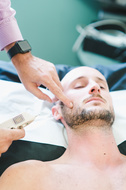
A 15 year old girl developed R shoulder pain one year ago after sleeping on it weird. Pain is constant and unable to raise hand above shoulder height (for instance raising her hand in school to ask a question).
3 months after the onset she had a diagnostic ultrasound which found a small supraspinatus tear (rotator cuff muscle). She then had 24 physical therapy visits over 12 weeks with no improvement. 2 months later she had a shoulder MRI - this did NOT show a supraspinatus tear.
11 months after initial onset the patient was referred to me. Pain was still constant (10/10 on VAS) EXSTORE exam was as follows:
•unable to flex shoulder above 90 deg on R
•scapular stability (serratus anterior) on R is inhibited
•during testing of serratus anterior upper trapezius is in spasm
•c spine ROM to the left is 45 deg
•patient cannot do any pushup or modified pushup in school gym class.
•Patient is afraid of needles.
TREATMENT
•the patient agrees to only one needle with some convincing from her mother but does NOT agree to Pointer Plus stimulation.
•I insert needle into serratus anterior with a twitch response - and leave for 30 seconds then follow up with some manual fascial release to the mid axillary line.
RESULT
The patient was off for Christmas for 2 weeks and when she returned she reported her shoulder was 80% less painful (2/10 of VAS)
•shoulder flexion improved to 170 degrees and the scapular stability was 100% stable on EXSTORE re-exam. Her c spine ROM was now 80 deg rotation bilateral.
DISCUSSION
Being specific with your assessment will pay dividends. Take diagnostic imaging into consideration but do not lean on it - do a functional exam. For a joint to move you need two things: muscles to stabilize the joint being moved and muscles to do the moving. This is why learning to assess and treat the serratus anterior is non-negotiable when aspiring to become consistently proficient in treating shoulder and neck dysfunction. This girl had 24 visits with another therapy. 24 visits! Clearly those therapists didnt know what they didnt know. We have the tools and its easier than you think folks.
This is why I stopped automatically giving a set % discount to whatever group/type of patient.
This video gives you practical ways to identify, address, and improve real-world pain presentations in your clinic.
Register for the next EXSTORE course or book a refresher if you need to brush up:
https://aseseminars.com/event/the-exstore-orthopedic-system-for-dry-needlers
every once in a while I will have a very overweight patient with neck tension. The fat near the neck makes it hard to always have the most accurate placement of what I am looking to do since it rolls in prone. Sometimes i will just needle with them sitting. Any suggestions for easier needling?
Can you post a list of all the courses available on ASE seminars? the sorting normally needs specific names of the course to find it but I am looking to just see all the topics that ASE seminars covers. I am looking to create a list of articles that can be created based upon the courses that are taught here. A course that is taken can have an article created from it explaining to patients why they are in the right place. These articles can reduce costs of advertising over time by making a person a local authority with google using its algorithm to send you traffic. We aren't giving direct treatment strategies but overview articles it seems to guide purchase.
Example : Difficulty to Rank /100 : Volume of Searches a month you are part of by writing an article that ranks well
Sciatica / 72 Difficulty / 450,000 searches
Anxiety / 95 difficulty / 368,000 searches
carpal tunnel / 63 difficulty / 301,000 searches
low back pain / 65 difficulty / 246,000 searches
Tennis elbow / 75 difficulty / 165,000 ...
I am looking at webinars to download for the month of December and would love your input. What topics haven’t you seen lately? Anything you’re curious about, want to brush up on, or feel like we do not cover enough? Drop your ideas — I want to make sure this month is something fresh.















